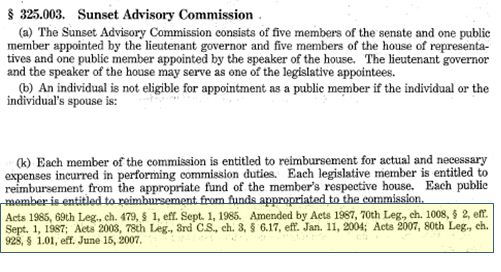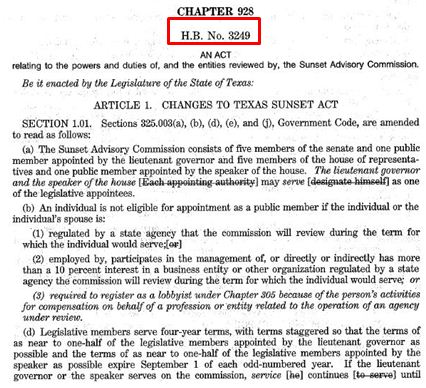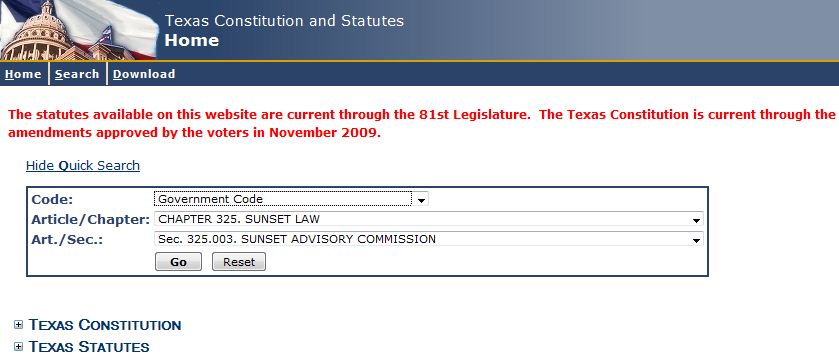
Legislative histories are connected to individual bills that have passed and become session laws, so you need to know the bill number and the legislative session in which the bill was enacted.
If you know the subject of the legislation but not the specific statutory section or sections that cover that topic, you can read more about subject searching.
Once you identify a particular statutory section, take a look at the legislative history annotations that immediately follow the statutory text (the “legislative summary”):
 The legislative summary provides citations to the session laws of legislation that enacted and/or amended the statute. Vernon’s Prior Laws section further lists the session law citations for similar laws that have subsequently been repealed (see the note below on nonsubstantive revisions for more information).
The legislative summary provides citations to the session laws of legislation that enacted and/or amended the statute. Vernon’s Prior Laws section further lists the session law citations for similar laws that have subsequently been repealed (see the note below on nonsubstantive revisions for more information).
A statute is usually the product of multiple session laws. If the statutory section in question has been amended more than once and the legislative history is unclear, you can begin by looking up the session law of the latest amendment and work backwards through each previous amendment listed in the legislative history note until you locate the act in which the statutory language in question appeared.
The legislative summary citations always list the session and chapter number (chapter numbers are assigned to enacted legislation in the order they were passed by the legislature during a session). Sometimes (typically for recent legislation), a legislative summary citation also includes the bill number. In that case, you have the information you need and can move on to Step 2: Bill History.
Citations That Do Not Include the Bill Number
If you only know the chapter number, you can either locate the bill number using the Search by Chapter feature in the Legislative Reference Library’s Legislative Archive System Direct Search, or look up the bill number listed in the session law.
The Legislative Reference Library’s Legislative Archive System provides information about legislation from the first regular session to the most recent session. Information available in the system varies by session, but a page for a piece of legislation will typically list the bill number and provide access to session law (for early bills, information is limited to a link to the session law). For many sessions, the Legislative Archive System also provides access to various legislative history documents related to that bill.
Session laws are available in print in the General and Special Laws of the State of Texas, and they are also accessible online from various sources. Often, online codes will provide direct links from the legislative summary to more recent session laws or final versions of bills. For more information about Texas session laws and how to locate them, see the subsection about Texas session laws.
As you work through Step 1 to determine the bill and session number (or year) of the legislation that enacted the statutory language, keep in mind that Texas statutes have undergone a nonsubstantive revision. The Texas Legislative Council (TLC) is required by law (section 323.007 of the Texas Government Code) to carry out a complete nonsubstantive revision of the Texas statutes. The TLC explains that "[T]he process involves reclassifying and rearranging the statutes in a more logical order." (For more information, see the TLC's Code Projects page. The Legislative Reference Library of Texas also provides statutory revision documents related to the initial adoption of codes and code sections.)
If a bill's caption states that a revision, correction, or addition was "nonsubstantive," this means that the bill was part of the statutory revision program and you will need to research a different bill to determine legislative history.
Texas’ nonsubstantive revision process also means that often topics covered in current codes were also addressed in a repealed section of the old (and largely replaced) Revised Civil Statutes or a repealed code. For a current code section, to identify an equivalent provision, if any, in the Revised Civil Statutes or a prior code, consult a Derivation table (available in the print Vernon’s or on Lexis) or the Prior Laws section of Vernon’s Editor’s and Revisor’s Notes below individual provisions in print or on Westlaw. Disposition tables (available in the print Vernon’s and on Westlaw and Lexis) allow researchers to determine where prior laws ended up in the current codes.
Once you have located your statutory section—in this case, section 325.003 of the Government Code—look at the end of the section at the (unlabeled) credits and/or Historical and Statutory Notes. (Highlighted below, by red boxes.) The information in these sections gives you a citation to the session laws, where you can find the original text of the bill that created this law.

You must also be sure to check the pocket part located in the back of the volume for updated history. In this case, there was additional legislative action taken after the bound volume was printed, which is referenced in the pocket part.

Since none of the listed citations include the bill number, use these citations to search the Legislative Archive system, which typically includes the bill number and session laws, or locate the session laws elsewhere online or in print in the General and Special Laws of the State of Texas.
One of the session laws amending section 325.003 of the Government Code was Acts 2007, 80th Legislature, chapter 928, section 1.01. To find this session law, you can look up Chapter 928 online via the Legislative Reference Library's Legislative Archive System Direct Search using the Search by Session Law Chapter option or in the volumes of the General and Special Laws of Texas for the 80th Legislature.
The Legislative Reference Library provides access to session laws online, but typically the bill number will be listed on the main page for that legislation.
If you do look at the session law, the bill number can be found right below the chapter heading, as shown in the red box below. You now know that the original language from this law came from House Bill Number 3249 in the 80th Legislature.

Now that you have the bill number, proceed to Step 2: Bill File.
If researching online, go to the legislature's Texas Constitution and Statutes page. You will be able to navigate directly to the section using the drop-down menus, as illustrated below.

Once you click "Go," the statute, section 325.003 of the Government Code, will open up in a new window.

Next, scroll to the bottom of section 325.003, where you will find citations to the session laws that have enacted and amended this statute.

If you only want to look at the most recent amendment, you can click on the hyperlink in this section, which will open up the underlying legislative bill that created the law, in this case, 80(R) H.B. 3249. This will allow you to move ahead to Step 2: Bill File.

If you need to look at the older session laws, you can use these citations to search the Legislative Archive system, which typically includes the bill number and session laws (see the above example), or locate the session laws elsewhere online or in print in the General and Special Laws of the State of Texas. For more information about Texas session laws and how to locate them, see the subsection About Texas Session Laws.
